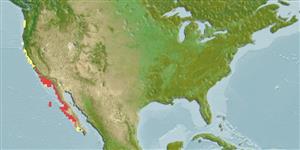>
Perciformes/Serranoidei (Groupers) >
Serranidae (Sea basses: groupers and fairy basslets)
Etymology: Paralabrax: Greek, para = the side of + Greek, labrax, -akos = a fish, Dicentrarchus labrax (Ref. 45335).
More on author: Girard.
Environment: milieu / climate zone / rango de profundidad / distribution range
Ecología
marino bentopelágico; rango de profundidad 1 - 61 m (Ref. 96339), usually 3 - 25 m (Ref. 32351). Subtropical; 48°N - 23°N, 126°W - 109°W
Eastern Pacific: Columbia River in Washington, USA to southern Baja California, Mexico.
Tamaño / Peso / Age
Madurez: Lm ? range ? - ? cm
Max length : 72.0 cm TL macho / no sexado; (Ref. 2850); peso máximo publicado: 7.0 kg (Ref. 9342); edad máxima reportada: 34 años (Ref. 56049)
Usually found in or near kelp beds, shallow water and to about 50 m but mostly from 2.4-21m . Found throughout water column. Large specimens usually occur in deeper water. Juveniles feed on benthic invertebrates (especially crustaceans); adults feed on fishes and cephalopods (Ref.9342). Both juveniles and adults may feed on plankton when abundant (Ref.9342). Pelagic spawners (Ref. 56049). Also caught with troll lines (Ref. 9342). Excellent food fish and an important game fish (Ref. 9342).
Pelagic spawner (Ref. 56049). Spawning aggregations are a significant component of the reproductive behavior of this species (Ref. 59326). Also Ref. 103751.
Eschmeyer, W.N., E.S. Herald and H. Hammann, 1983. A field guide to Pacific coast fishes of North America. Boston (MA, USA): Houghton Mifflin Company. xii+336 p. (Ref. 2850)
IUCN Red List Status (Ref. 130435: Version 2025-1)
Threat to humans
Harmless
Human uses
Pesquerías: comercial; pesca deportiva: si
Herramientas
Special reports
Download XML
Fuentes de Internet
Estimates based on models
Preferred temperature (Referencia
123201): 12 - 20.1, mean 14.8 °C (based on 12 cells).
Phylogenetic diversity index (Referencia
82804): PD
50 = 0.5020 [Uniqueness, from 0.5 = low to 2.0 = high].
Bayesian length-weight: a=0.00933 (0.00441 - 0.01974), b=3.05 (2.88 - 3.22), in cm total length, based on LWR estimates for this species & Genus-body shape (Ref.
93245).
Nivel trófico (Referencia
69278): 3.9 ±0.4 se; based on diet studies.
Generation time: 10.7 ( na - na) years. Estimated as median ln(3)/K based on 1
growth studies.
Resiliencia (Referencia
120179): Bajo, población duplicada en un tiempo mínimo de 4.5-14 años (K=0.10; tm=2.5; tmax=34).
Fishing Vulnerability (Ref.
59153): High to very high vulnerability (67 of 100).
🛈
Nutrients (Ref.
124155): Calcium = 36.5 [15.5, 73.9] mg/100g; Iron = 0.698 [0.381, 1.332] mg/100g; Protein = 17.7 [15.9, 19.4] %; Omega3 = 0.305 [0.171, 0.541] g/100g; Selenium = 28.9 [12.5, 60.3] μg/100g; VitaminA = 34.4 [10.0, 127.5] μg/100g; Zinc = 0.695 [0.494, 1.018] mg/100g (wet weight);
